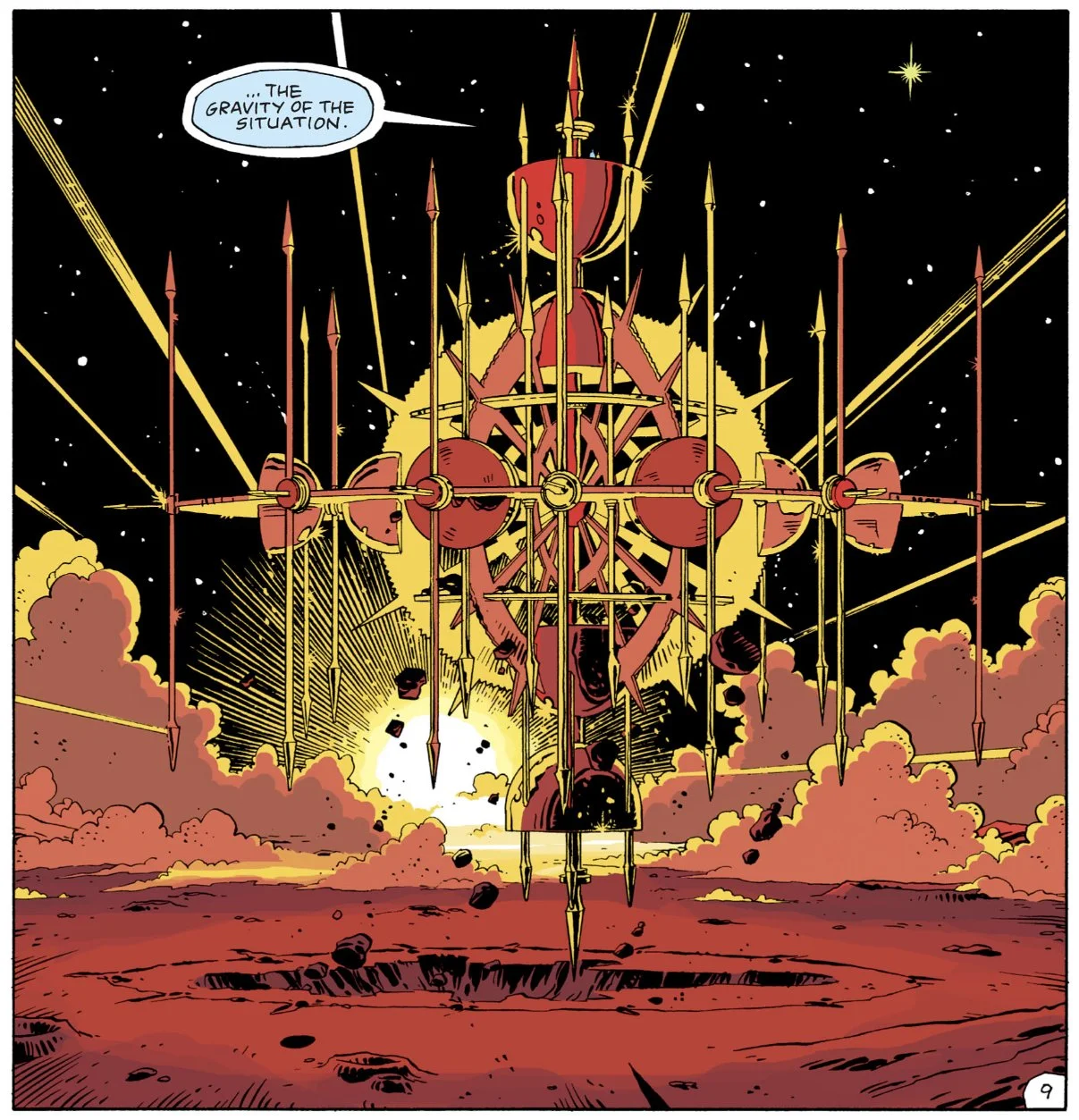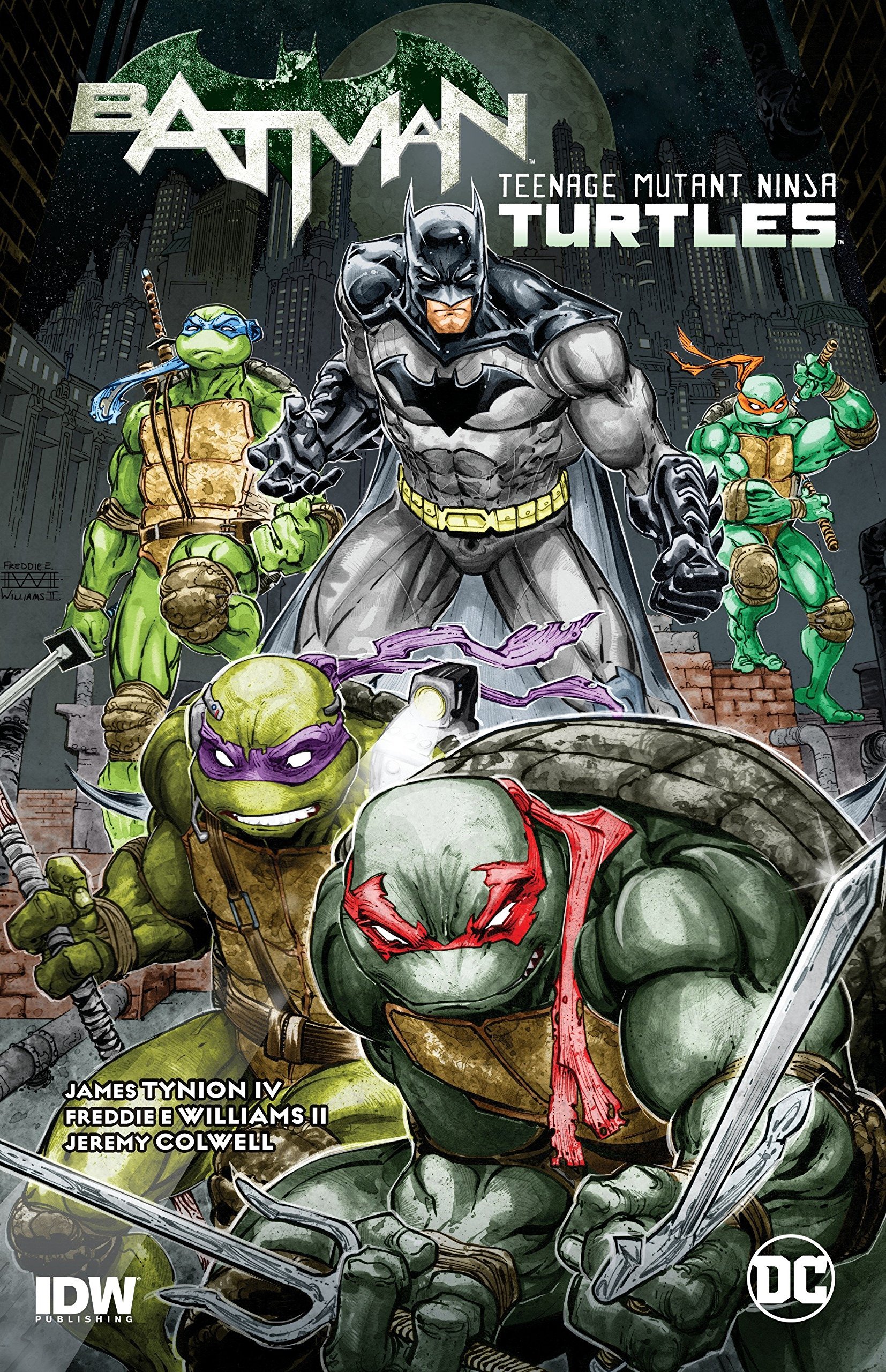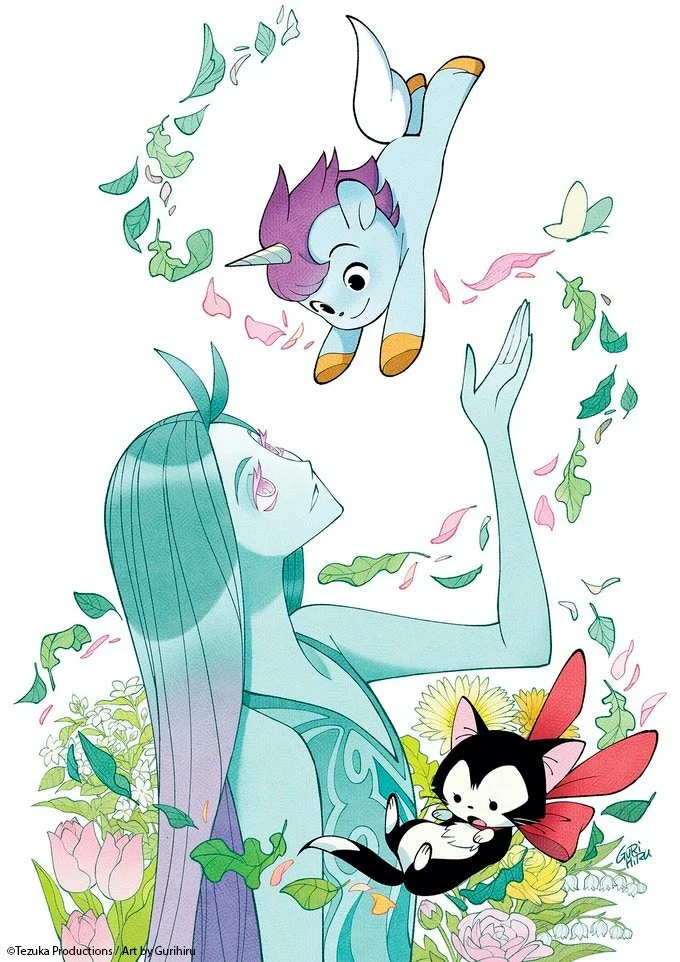Comics Anatomy: The First Night of Klaus
By Sean Dillon — In many regards, Klaus is one of the most important works of Grant Morrison’s late career. However, it is often approached by writers like myself as a portentous dissertation on the failures of Grant Morrison in comparison to Alan Moore. And while elements of that are within the text (Grant Morrison, after all, has impressive cheekbones), it would be remiss of me not to acknowledge that it’s also a fun, delightful series about Santa fighting fascists. And perhaps nowhere is this more apparent than in the first night of Santa’s gift giving crusade.
The scene consists of six pages of roughly two to six panels a piece. The scene depicts our hero, Klaus, entering the village of Grimsvig to deliver presents while outsmarting and out maneuvering the guards. But it’s the specifics of the scene, the individual little moments that Morrison and artist Dan Mora add that truly makes it work.
The sequence opens with a massive panel, taking the entire page, with the remaining two overlapping the image. This sets the setting for what is about to happen. It’s night, there’s a blizzard going on, and we can see two men standing in the distance, alight by a single fire, drawn by Mora to look like a giant candle.
However, more interesting is what’s in the foreground of this sequence. While everything else outside of the circle the two guards are within is colored with dark blues and blacks, in the foreground we can clearly see through the blizzard obscuring many parts of the sequence a poster of Lord Magnus. Magnus is the main antagonist of the series, whose presence within the town can be felt even when he is not there.
The man is cold in nature, a cruelty brought upon by a sense of inadequacy of not being as good as his bearded, hermetic counterpart. As such, he has made the world around him cold, hoarding what little warmth for himself. (It’s hard to tell in this image, but the only other light on the page is in the castle above, highlighting both Magnus’ power of having light while the town he rules is consumed by darkness, and his coldness by how little we can see of it.)
From here, we can see a close up of the two men. Their eyes are blinded by the snow, unable to see even in the brightness of the light. Eyes are an important marker throughout Klaus, with characters' visibility often highlighting their understanding of the world. Those on the villainous side are frequently drawn with hard, often closed eyes while the goodies have eyes that are softer and open wide, like a cartoon character. We then cut to a close up of Klaus’ hands (and only his hands) making a snowball. Throughout the sequence, Klaus is left at a distance from the reader. In shadows or too far away to get a detailed look at him.
This is perhaps best highlighted in the next page. The first four panels of the page create a single image of the rooftops of Grimsvig. However, they are all set at a different time. Each one builds from the snowball’s initial throw and implied landing on the rooftop to the ball rolling down and down the rooftop, its target only implied. Furthermore, we don’t actually see Klaus throw the ball. It’s already midarc as we cut to the rooftops. Much like its landing, the throw is implied based on the fact that we see Klaus making the ball.
The next panel shifts angle and (though it’s subtle) time by showing us where the snowball is going to land. The bright light that surrounds the two guards suddenly becomes a target for the ball to land. Tension, then, is built as to whether or not the ball will hit them or if they will get out of the way in time. And yet, the ball isn’t in the panel. The temporal implication of the moment hints that this conversation is occurring as the ball is rolling on the rooftop.
The final panel of the page overlaps the previous panel, interrupting the flow of the sequence to highlight what the two characters we have been following have just noticed: Klaus’ Grappling Hook attaching itself to the walls of the village. By doing this, the reader is drawn into the moment alongside the guards. The sudden intrusion of the hook is as shocking to us as it is to the guards.
Furthermore, the panel itself is off with the pattern of the previous panels. Where those panels were uniform in width, this one is much stockier. The structure of the page would have allowed it to be in frame with the rest of the sequence, but it would be much slimmer and wider, detracting from the impact it has on the page. Its intrusive nature highlights the intrusive nature of Klaus upon the village.
The next page highlights this as it opens with the first full glimpse of our titular hero ascending the wall. Both the verticality and size of the panel indicate the scale Klaus must endure in order to climb up the walls of Grimsvig. And the skewed angle of the second panel indicates the difficulty of successfully climbing the wall. Note also Klaus’ visible eyes, which can be seen even through the darkness of night and his hood. And yet, there’s still a degree of distance between Klaus and the reader. The shadows obscure many of the details on his face. We then return to the two guards, whose panel overlaps the first panel to indicate a sense of timing for these events. Once again, events are happening simultaneously to one another.
Additionally, note the hooded guard’s face. Unlike Klaus’, we can plainly see his face beneath the hood. For all that we are aligned with Klaus narratively, we are still placed in the perspective of these guards. They do not see the full extent of who Klaus is or what he is doing any more than we do. Sure, we have a general idea of Klaus M.O. based on the whole “This is a comic about Santa the Barbarian” thing it has going. In turn, there’s a desire for the guards to not be hurt by the inevitable; that they may escape the target before it’s too late.
However, the snowball that had been set up for the previous two pages finally lands. Perhaps most interestingly is the fact that we never actually see the snowball land. Indeed, throughout the six page opening of this first night on the town, we never actually see any of the traditional punches, kicks, or the like one would expect from an action sequence such as this. Instead, we are given after images of the events. The snowball about to hit the guards, the knocked out guard covered in a bag.
It should perhaps note that, within the bibliography of Grant Morrison, they have never really shown an interest in traditional action punch ups. Often, works that feature raw, active violence tend to be shown as, to some degree or another, horrific. Be it the cyborg animals utterly shredding people to bits, Batman literalizing his name as the one eyed face of a child stares back at him, or all of Nameless. Even King Mob, their most traditional action hero, is called out for his violent tendencies, be it actively by his fellow characters, or implicitly through an issue focusing on the life of one of the faceless goons he mowed down. For Morrison, violence, while not a bad answer, isn’t the only answer (in no small part to their father, a socialist pacifist who would be down to fight if needed, but always used their brains first). Indeed, more often than not, violent responses tend to end with the acts biting their heroes in the ass (See Animal Man feeling hollow after getting revenge against those who killed his family).
And yet, this sequence with Klaus remains fun (as opposed to horrifying) because our overall perspective remains with Klaus, even if we move away from him from time to time. The tone from Mora never goes into the sheer terror a Burnham, Sharp, or even Bond would do. It’s not that Mora can’t do horror (just look at the unnamed demon’s true form). But his style here invokes more action adventure hijinks than the brutal horror it could provide.
This is highlighted by the next page, which features the first heroic shot of Klaus in the issue, descending from the walls like a snowball from a rooftop. Behind him, we see more of Magnus’ posters, this time multiple versions of them. They are all uniform in nature, with the stern coldness one would expect. And yet, they are drawn less like a recruitment poster and more like a sketch. While extremely detailed, you can see a distinction in the inked biceps of Klaus and the penciled sketches of Magnus. There’s a sense that, for all his power, there’s something lacking in Magnus’ character. (Tellingly, one of the posters is covered up by the next panel on the page.)
And yet, there is still a sense of distance between us and Klaus, even if he is still our perspective character. In the big heroic shot, his face remains obscured both by the snow and his hood. Note that, though we can see his eyes, his face nevertheless remains shrouded in the hood, more so than even the previous page. We are not seeing the full actions at play, and yet we can see the aim of the mission.
This is best highlighted by the gift in Klaus’ hand. It’s colored far brighter than even the fire of the previous pages, popping in the darkness of the overall page. It’s even brighter than Klaus himself, who has an overall muted color scheme, even if it’s one that’s brighter than the world around him. Even when out of Klaus’ hands, it emanates a brightness that warms the front door of the house it was placed upon. Indeed, the town itself looks brighter in this moment than it did before.
From here, the cloaked gift giver is being hunted by the remaining guards. It should be noted that there’s a sense of clarity to this sequence. The panels are largely uniform in shape and meaning. There’s never a point where you’re confused as to the order in which you are meant to read this sequence in. We can clearly see where Morrison and Mora want our eyes to focus on. In the first panel, we are meant to initially focus on Klaus, as he is in the foreground of the image. In turn, his gaze, the direction of his breath, and the natural inclination of an American Comics readership points us in the direction of the guards, whose distinct red clothing makes them visible in the darkness.
Our attention is moved to a single guard on his own. Note his placement on the panel is directly below where the previous panel had the guards. Our eyes naturally move downward to see him, illuminated in spotlight, much like the two guards we followed in the beginning. Like those two guards, the spotlight acts as a target for Klaus to hit, with the darkness surrounding it even darker than before.
And hit most certainly does, in what is perhaps the one moment of traditional action in the whole scene. However, the moment is quick and efficient. We only see the initial bag covering the guard’s head without any of the subsequent need to knock him out, tie him up, or place him in the right spot. We don’t even see Klaus fully sneak up on the unsuspecting guard. All that we do see is Klaus implicitly land behind the guard, then cover him up. One, two, we’re done.
Immediately after this, we turn our attention to the remaining four guards, all of whom are draped in the spotlight. As with the guard who was taken, their surroundings are dark and foreboding. Gone is the brightness of the gift. Thus, the tension rises: will this be another target for Klaus to hit? Or will he move on to more pressing matters such as delivering gifts to the good girls and boys?
As the final page of the sequence indicates, the answer was the latter as, contrary to the guard’s claims (whose eyes are, tellingly, closed), Klaus got away. Furthermore, there’s the image of Magnus, which has recurred throughout the sequence. Here, Klaus has altered the image slightly to make it into a point of mockery. No longer the stern authoritarian, the sketch now resembles a fool, incapable of catching our hero. Additionally, there’s the presence of the Joy rune, the calling card of old Saint Nick. The spotlight of the fire, with the poster directly inside of it (though not at the direct center of it) indicates that while the purpose of this night is to target Magnus, he is ultimately not the main interest.
Instead, that is what is revealed in the following page: to give gifts to children. Klaus will go throughout the village of Grimsvig, evading guards, climbing walls, and breaking the law, just to put a smile on the faces of a town of miserable children. To reject the austerity of control Magnus’ stern face has over the village because it dimmed the eyes of children.
There are other sequences within Klaus that are worth exploring, but it is here that we see the aim of the series. Not the traditional punch up one would expect from the caped crusaders Morrison made their name with (and Mora would become synonymous with in the years that followed Klaus). But rather one that places the focus not on mere violence, but upon fun, exciting moments such as these.
Read other installments of Comics Anatomy!
Sean Dillon is a Writer/Editor for a number of publications, including PanelXPanel, Arcbeatle Press, Comfort Food Comics, Comic Book Herald, among several others. He is also the author of the book One Must Imagine Scott Free Happy and The Tower Through The Trees. His main blog is http://thekinginredandblue.blogspot.com and his Patreon is http://patreon.com/seandillon. He can be found on most social media outlets @deathchrist2000.












